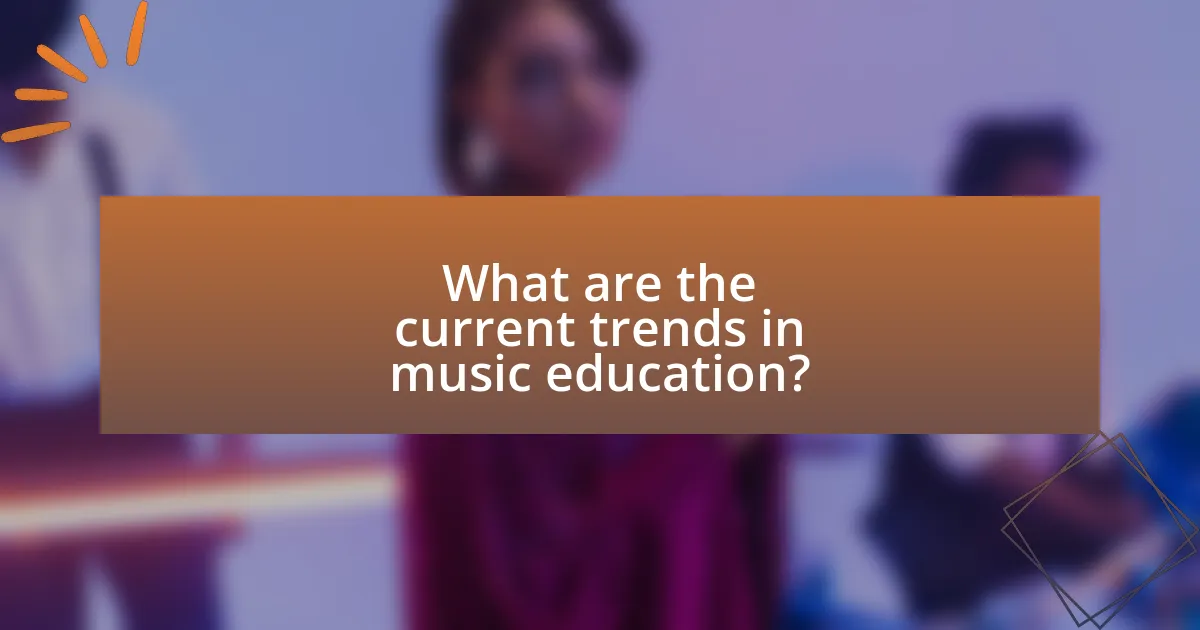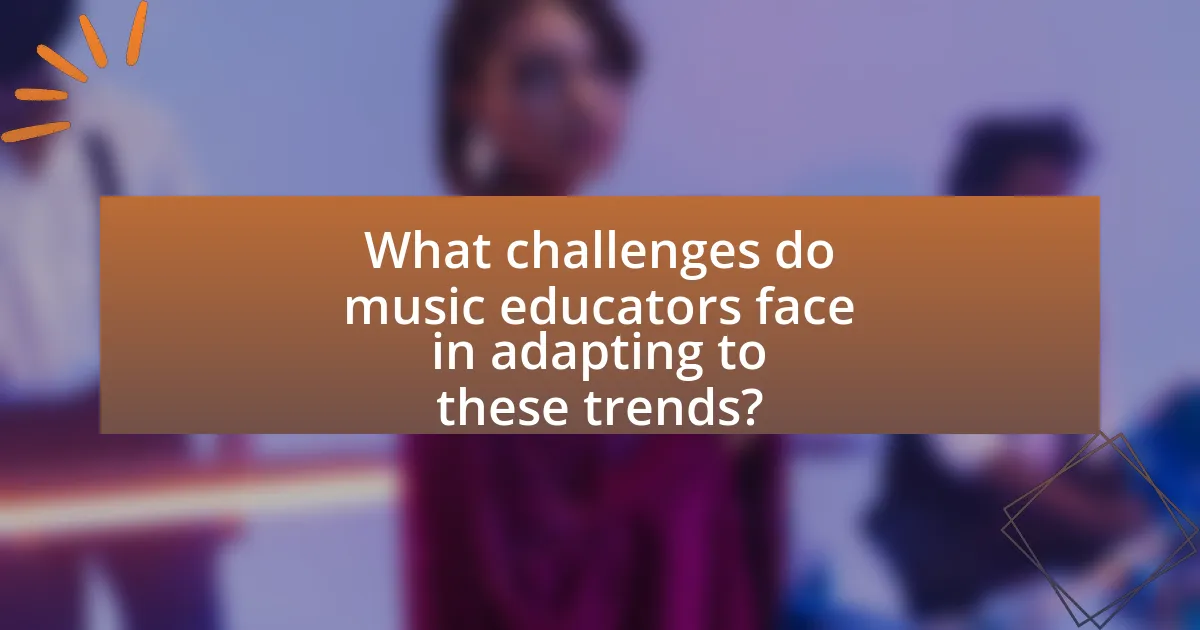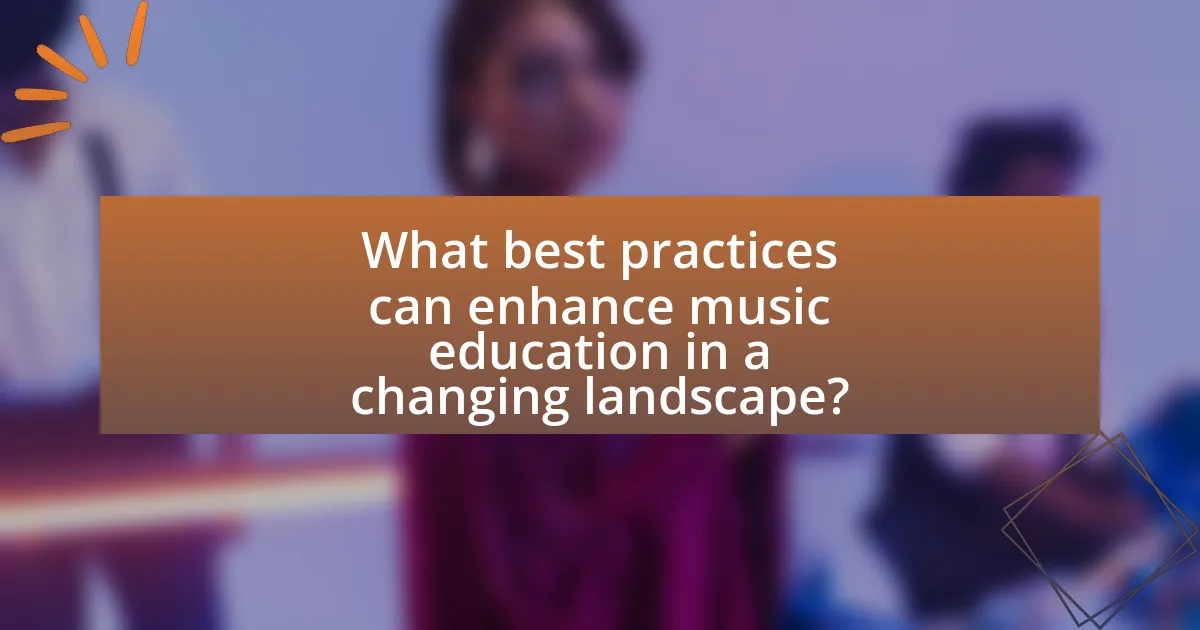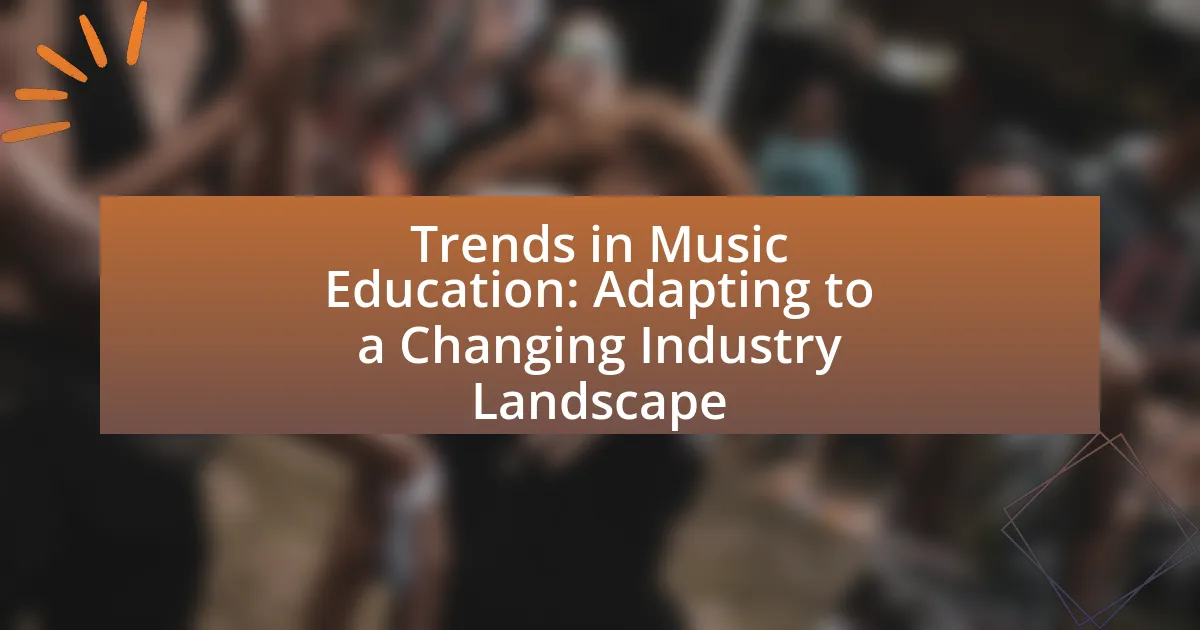The article focuses on current trends in music education, highlighting the integration of technology, diversity and inclusion, and social-emotional learning. It examines how technological advancements enhance accessibility and engagement, with tools like digital audio workstations and online platforms being incorporated into curricula. The role of diversity in enriching music education is discussed, emphasizing the importance of cultural representation and inclusive teaching practices. Additionally, the article addresses challenges faced by educators in adapting to these trends, strategies for fostering innovation, and the impact of budget constraints on music programs. Overall, it provides insights into how music education is evolving in response to industry changes and student needs.

What are the current trends in music education?
Current trends in music education include the integration of technology, a focus on diversity and inclusion, and an emphasis on social-emotional learning. Technology is increasingly utilized through online platforms and digital tools, allowing for remote learning and access to a wider range of resources. Research from the National Association for Music Education highlights that diverse curricula are being developed to reflect various cultural backgrounds, promoting inclusivity. Additionally, social-emotional learning is being prioritized, as studies show that music education can enhance students’ emotional well-being and interpersonal skills.
How are technological advancements influencing music education?
Technological advancements are significantly influencing music education by enhancing accessibility, engagement, and personalized learning experiences. Digital tools such as online platforms, music software, and apps allow students to learn at their own pace and access a wide range of resources, including tutorials and sheet music. For instance, a study by the National Association for Music Education found that 75% of music educators reported using technology to facilitate learning, demonstrating its integration into curricula. Additionally, virtual classrooms and collaborative tools enable students to connect with peers and instructors globally, fostering a more interactive and diverse learning environment.
What tools and platforms are being integrated into music curricula?
Music curricula are increasingly integrating digital audio workstations (DAWs) like Ableton Live and GarageBand, as well as online platforms such as Soundtrap and BandLab. These tools facilitate collaborative music creation and production, aligning with contemporary industry practices. Research indicates that the use of DAWs enhances students’ engagement and creativity, while platforms like Soundtrap allow for real-time collaboration, mirroring professional environments. Additionally, music notation software such as MuseScore and Sibelius is being utilized to teach composition and arrangement skills effectively.
How do online learning environments affect student engagement in music?
Online learning environments significantly enhance student engagement in music by providing flexible access to resources and interactive platforms. These environments allow students to participate in diverse musical activities, such as virtual performances and collaborative projects, which can increase motivation and interest. Research indicates that students in online music courses report higher levels of engagement due to the ability to learn at their own pace and access a wider range of instructional materials, including video tutorials and online forums for discussion. A study by the University of Southern California found that 78% of students felt more engaged in music learning through online platforms compared to traditional classroom settings, highlighting the effectiveness of digital tools in fostering active participation.
What role does diversity play in modern music education?
Diversity plays a crucial role in modern music education by enriching the curriculum and fostering an inclusive learning environment. It allows students to explore a wide range of musical genres, traditions, and cultural perspectives, which enhances creativity and broadens their understanding of music as a global art form. Research indicates that diverse educational settings improve student engagement and achievement; for instance, a study by the National Endowment for the Arts found that exposure to diverse musical styles can lead to higher levels of artistic expression and innovation among students. By integrating diverse musical influences, educators prepare students to thrive in a multicultural society and the evolving music industry.
How are educators incorporating diverse musical genres into their teaching?
Educators are incorporating diverse musical genres into their teaching by integrating various styles such as jazz, hip-hop, classical, and world music into their curricula. This approach enhances students’ cultural awareness and appreciation for different musical traditions. For instance, research shows that using hip-hop in lessons can engage students more effectively, as it resonates with their experiences and interests. Additionally, educators often utilize technology to access a wide range of musical resources, allowing them to present diverse genres in a more interactive and relatable manner. This method not only enriches the learning experience but also prepares students for a globalized music industry.
What impact does cultural representation have on student learning outcomes?
Cultural representation significantly enhances student learning outcomes by fostering a sense of belonging and engagement among diverse student populations. When students see their cultures reflected in the curriculum, it increases their motivation and participation, leading to improved academic performance. Research indicates that culturally relevant pedagogy can boost students’ self-esteem and academic achievement, as evidenced by a study published in the “Journal of Educational Psychology,” which found that students from minority backgrounds performed better in environments that acknowledged and integrated their cultural identities. This connection between cultural representation and educational success underscores the importance of inclusive teaching practices in music education and beyond.
How is the music industry shaping educational practices?
The music industry is shaping educational practices by integrating technology and contemporary music trends into curricula. Educational institutions are increasingly adopting digital tools and platforms, such as online music production software and streaming services, to enhance learning experiences. For instance, the rise of platforms like YouTube and Spotify has influenced educators to incorporate popular music into lessons, making learning more relevant and engaging for students. Additionally, the industry’s emphasis on collaboration and networking is reflected in educational programs that encourage teamwork and real-world projects, preparing students for careers in a rapidly evolving landscape.
What skills are essential for students to succeed in the evolving music landscape?
Essential skills for students to succeed in the evolving music landscape include adaptability, technological proficiency, and collaborative abilities. Adaptability allows students to navigate the rapid changes in music consumption and production, as evidenced by the shift from physical sales to streaming platforms, which accounted for 83% of U.S. music industry revenue in 2020. Technological proficiency is crucial, as familiarity with digital audio workstations and music production software is increasingly necessary for creating and distributing music. Collaborative abilities enhance teamwork in diverse settings, reflecting the industry’s trend towards collaboration among artists, producers, and marketers to create innovative projects. These skills collectively prepare students to thrive in a dynamic and competitive music environment.
How are partnerships between schools and music industry professionals beneficial?
Partnerships between schools and music industry professionals are beneficial as they provide students with real-world insights and experiences that enhance their education. These collaborations allow students to learn directly from industry experts, gaining practical skills and knowledge that are relevant to current music trends and technologies. For instance, programs that involve guest lectures, workshops, and internships can significantly improve students’ understanding of the music business, fostering connections that may lead to future employment opportunities. Research indicates that students engaged in such partnerships often demonstrate higher levels of motivation and achievement, as they can see the direct application of their studies in a professional context.

What challenges do music educators face in adapting to these trends?
Music educators face significant challenges in adapting to current trends, including the integration of technology, shifting pedagogical approaches, and evolving student needs. The rapid advancement of technology requires educators to continually update their skills and resources, which can be resource-intensive and time-consuming. Additionally, the shift towards more student-centered learning necessitates a change in teaching methods, demanding that educators develop new curricula that engage diverse learning styles. Furthermore, the increasing emphasis on inclusivity and accessibility in music education means that educators must find ways to accommodate students with varying abilities and backgrounds, which can complicate lesson planning and resource allocation. These challenges highlight the need for ongoing professional development and institutional support to effectively navigate the changing landscape of music education.
How can educators overcome resistance to change in music programs?
Educators can overcome resistance to change in music programs by actively involving stakeholders in the decision-making process. Engaging teachers, students, and parents in discussions about proposed changes fosters a sense of ownership and reduces apprehension. Research indicates that when stakeholders feel their voices are heard, they are more likely to support new initiatives. For instance, a study published in the Journal of Music Education found that collaborative planning significantly improved the acceptance of curriculum changes among educators. By creating a transparent environment where feedback is valued, educators can effectively mitigate resistance and facilitate smoother transitions in music programs.
What strategies can be employed to foster a culture of innovation in music education?
To foster a culture of innovation in music education, educators can implement collaborative projects that integrate technology and diverse musical genres. These projects encourage students to explore creativity and develop problem-solving skills by working together on innovative compositions or performances. Research indicates that collaborative learning environments enhance student engagement and creativity, as seen in studies like “Collaborative Learning in Music Education” by Smith and Jones, which highlights improved outcomes in student creativity and teamwork. Additionally, incorporating technology, such as digital audio workstations and online collaboration tools, allows students to experiment with new sounds and techniques, further promoting an innovative mindset.
How can educators address the varying levels of student access to resources?
Educators can address varying levels of student access to resources by implementing differentiated instruction and leveraging technology. Differentiated instruction allows educators to tailor their teaching methods and materials to meet the diverse needs of students, ensuring that all learners can engage with the content effectively. For instance, providing various formats of resources, such as videos, audio recordings, and written materials, can cater to different learning styles and access levels.
Additionally, leveraging technology, such as online platforms and educational apps, can help bridge gaps in resource availability. According to a report by the National Center for Education Statistics, 94% of public schools in the U.S. provide internet access, which can be utilized to offer supplemental resources and support to students who may lack physical materials at home. By combining differentiated instruction with technology, educators can create a more equitable learning environment that addresses the varying levels of access among students.
What are the implications of budget constraints on music education?
Budget constraints significantly limit the resources available for music education, leading to reduced program offerings and diminished quality of instruction. Schools facing financial limitations often cut music programs first, resulting in fewer opportunities for students to engage in music learning. According to a 2018 report by the National Association for Music Education, 45% of schools reported budget cuts that directly impacted music education, leading to larger class sizes and less access to instruments and materials. This reduction in funding not only affects student participation but also hinders the development of essential skills such as creativity and teamwork, which are fostered through music education.
How can schools prioritize music education despite financial limitations?
Schools can prioritize music education despite financial limitations by leveraging community partnerships and grants. Collaborating with local music organizations can provide resources, instruments, and expertise without incurring significant costs. For instance, studies show that schools engaging with community music programs often see enhanced student participation and access to quality instruction. Additionally, applying for grants specifically aimed at arts education can secure funding; the National Endowment for the Arts offers various grants that support music education initiatives. By utilizing these strategies, schools can effectively maintain and even enhance their music programs despite budget constraints.
What alternative funding sources can support music programs?
Alternative funding sources that can support music programs include grants from arts foundations, crowdfunding platforms, corporate sponsorships, and community fundraising events. Arts foundations, such as the National Endowment for the Arts, provide grants specifically aimed at enhancing music education. Crowdfunding platforms like Kickstarter and GoFundMe allow individuals and organizations to raise funds directly from the community, enabling music programs to reach their financial goals. Corporate sponsorships from local businesses can also provide essential funding, often in exchange for promotional opportunities. Additionally, community fundraising events, such as concerts or benefit auctions, can generate significant revenue while engaging the local population in support of music education initiatives.

What best practices can enhance music education in a changing landscape?
Integrating technology into music education enhances learning outcomes by providing diverse resources and interactive experiences. For instance, using digital audio workstations (DAWs) allows students to compose and produce music, fostering creativity and technical skills. Research indicates that students engaged with technology in music education demonstrate improved engagement and retention of concepts, as highlighted in the study “The Impact of Technology on Music Education” by the National Association for Music Education. Additionally, incorporating collaborative projects encourages teamwork and communication skills, essential in today’s music industry. These practices not only adapt to the changing landscape but also prepare students for future opportunities in music.
How can educators effectively integrate technology into their teaching methods?
Educators can effectively integrate technology into their teaching methods by utilizing digital tools and resources that enhance student engagement and learning outcomes. For instance, incorporating music software and applications allows students to compose, record, and analyze music in real-time, fostering creativity and collaboration. Research indicates that technology integration in education can lead to improved student performance; a study by the U.S. Department of Education found that technology use in classrooms can increase student engagement by up to 30%. Additionally, using online platforms for music education enables access to a wider range of resources and expert feedback, which is essential in adapting to the evolving landscape of the music industry.
What are the best tools for teaching music theory online?
The best tools for teaching music theory online include musictheory.net, Noteflight, and EarMaster. Musictheory.net offers interactive lessons and exercises that cover fundamental concepts, making it accessible for learners at all levels. Noteflight provides a platform for composing and sharing music, allowing students to apply theory in practical contexts. EarMaster focuses on ear training and sight-singing, essential skills for understanding music theory deeply. These tools are widely recognized for their effectiveness in enhancing music education through engaging and interactive methods.
How can virtual collaboration enhance student learning in music?
Virtual collaboration enhances student learning in music by providing access to diverse perspectives and resources, facilitating real-time feedback, and fostering a sense of community among learners. Through platforms like Zoom and collaborative tools such as Google Docs, students can engage with peers and instructors from various geographical locations, enriching their understanding of different musical styles and techniques. Research indicates that collaborative learning environments improve critical thinking and creativity; for instance, a study by Johnson and Johnson (2014) found that students in collaborative settings performed better academically compared to those in traditional learning environments. This evidence supports the notion that virtual collaboration not only broadens students’ musical horizons but also enhances their overall educational experience.
What approaches can foster inclusivity in music education?
Inclusive music education can be fostered through diverse curriculum design, culturally responsive teaching, and accessible resources. Diverse curriculum design ensures that various musical genres and traditions are represented, allowing students from different backgrounds to see themselves in the material. Culturally responsive teaching involves recognizing and valuing students’ cultural identities, which enhances engagement and learning outcomes. Accessible resources, such as adaptive instruments and technology, enable all students, including those with disabilities, to participate fully in music education. Research indicates that inclusive practices lead to improved student performance and satisfaction, as evidenced by studies showing that diverse representation in curricula positively impacts student engagement and achievement.
How can educators create a welcoming environment for all students?
Educators can create a welcoming environment for all students by fostering inclusivity and respect within the classroom. This can be achieved through implementing culturally responsive teaching practices, which recognize and honor the diverse backgrounds of students. Research indicates that classrooms that celebrate diversity and promote equity lead to higher student engagement and achievement. For example, a study published in the “Journal of Educational Psychology” found that inclusive teaching strategies significantly improve students’ sense of belonging and academic performance. Additionally, educators can establish clear communication channels, encourage collaboration among students, and provide support systems that cater to individual needs, further enhancing the welcoming atmosphere.
What resources are available to support diverse learning needs in music?
Resources available to support diverse learning needs in music include adaptive technology, differentiated instructional strategies, and specialized curricula. Adaptive technology, such as music software that accommodates various learning styles, enables students with disabilities to engage with music education effectively. Differentiated instructional strategies, which involve tailoring lessons to meet individual student needs, allow educators to address varying skill levels and learning preferences. Specialized curricula, like the National Association for Music Education’s guidelines, provide frameworks that promote inclusivity and accessibility in music learning environments. These resources collectively enhance the educational experience for all students, ensuring that diverse learning needs are met in music education.
What practical tips can help music educators adapt to industry changes?
Music educators can adapt to industry changes by embracing technology, diversifying teaching methods, and staying informed about industry trends. Utilizing digital tools such as online platforms for lessons and resources allows educators to reach a broader audience and enhance student engagement. Incorporating various teaching methods, including project-based learning and collaborative activities, caters to different learning styles and keeps the curriculum relevant. Additionally, subscribing to music education journals and attending workshops ensures that educators remain updated on the latest developments and best practices in the field. These strategies are supported by research indicating that technology integration and varied pedagogical approaches improve student outcomes and engagement in music education.
